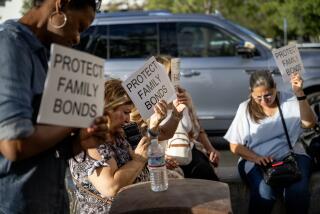Stretching the Family Circle : Building walls around our lives hasn’t given us safety or peace of mind. This year, experts say, we’ll work harder at building communities
- Share via
In the “stucco wasteland” of Poway, one family had had enough of the isolation, the self-imposed but socially mandated nightly retreat behind the alarm system and the automatic garage-door opener. They lived in a house with a two-car garage, a wet bar--and no front porch. They scarcely knew their neighbors, their mail carrier, or the kids who delivered pizza or the newspaper.
Feverishly, they dug up the front yard and installed a courtyard, a sort of outdoor living room. Almost instantly--magnetically, it seemed--grown-ups from nearby houses were depositing themselves in the Adirondack chairs scattered about the neighborhood’s first real gathering spot. Children congregated on the low stone wall that begged them to climb on it.
“It was like their own personal ‘Field of Dreams,’ ” recalled San Diego writer Richard Louv, who supplied this example of how American families, vintage 1994, are striving to create organic support systems that weave them into a super-extended family.
Louv--author of “Childhood’s Future,” “FatherLove” and, most recently, “101 Things You Can Do for Our Children’s Future”--joins a growing list of child advocates and family-watchers who see 1994 as a time of major realignment.
Families, they contend, are overlooking conventional boundaries as they reach outward in search of connection. The overused word community may make people’s eyes glaze over, yet common ground is definitely one keen goal. So, however, is a passionate yearning among families for a sense of safety and security that extends beyond their own triple-locked front doors.
In 1994, said Susan Nall Bales, director of children’s programs at the Benton Foundation in Washington, D.C., “We’re restirring the pot, rethinking the question of what kind of environments we want to provide for our families and for our children.”
Almost daily, organizations spring up as part of a vast, if still shapeless, family movement. Although lacking a unified voice or single leader, these groups represent a powerful numerical force that collectively recognizes the concerns of people who live together in an assortment of configurations.
In their efforts at advocacy, many of these groups are displaying a degree of political astuteness that some government leaders might find unnerving.
Issues pertaining to children and the family have traditionally been seen as soft and politically expendable, and family advocates were viewed largely as unsophisticated and disorganized. But as 1994 begins, these crusaders for family interests are entering the fray with new confidence and an agenda that politicians will have trouble ignoring. More than anywhere else, these advocates are expected to direct their energies to the two towering issues of health care reform and violence prevention.
They say they will approach their mission with a clearer sense of their constituency.
“Advocates for children and the family used to think we were speaking for some small percentage of our society. We thought in terms of categories, constituencies, the woes of the day,” said Jack Levine, director of the Florida Center for Children & Youth in Tallahassee. “Well, we were naive. The population for whom we are advocating is 100%.”
As an example of how the family movement is mobilizing, Levine said his group helped to register 60,000 new voters at Florida child-care centers, hospitals, nursing homes and schools in 1993. For 1994, his goal is to add 250,000 new voters. Just to make sure elected officials don’t overlook this voting bloc, “We’re going to have banners at our child-care centers saying ‘This is a 100% voter-registered child-care center.’ ”
Emergency, or backup, child care will be a top priority in the coming year’s discussion of family-centered issues, said Barbara Reisman of the Child Care Action Coalition in New York City. Reisman also advocates including a training program for child-care workers in President Clinton’s national service program.
Books in 1994 will pay more attention to issues pertaining to children’s mental health, said Toni Burbank, executive editor of Bantam Books in New York. “We’re seeing children much more as individuals. There’s less of a sense that children are these blank slates on which their parents write.”
In business, said Pamela Maraldo of the Planned Parenthood Federation of America, organizations and systems are relying less on traditional hierarchies and superstructures. In 1994, Maraldo said, that same boundary-less notion will apply to the family.
This means a widening acceptance of the kind of nonbiological family ties that occur when older people who are widowed choose to live together, or when single parents affix an additional adult to their household. “In some cases, you may find friendships replacing the traditional nuclear family,” Maraldo said.
Gay households have become so commonplace that many experts now list them under the “nuclear family” umbrella.
And, as the definition of the family widens, so does its focus. “You’ll see families taking on issues like how wide the sidewalk is in a new development,” said Louv, who has interviewed thousands of families for his research. Families may begin to look harder at the physical structures of their local schools--how safe are those drainpipes?--as well as the “family friendly” quality of day-care centers and workplaces.
*
Americans will begin to look more inclusively toward the next generation as well.
“I think you’ll see a growth in things like mentoring for someone who is not your own child,” said the Benton Foundation’s Bales.
In homes with adolescents, a sense of safe haven will be central in 1994.
“People are realizing that most of our communities and organizations and schools have not responded adequately” to the growing number of adolescents who are unsupervised in the after-school hours, said Ruby Takanishi of the Washington, D.C.-based Carnegie Council on Adolescent Development.
“People feel more concerned because of the growing fear of violence,” she said. “But there’s also a kind of shift going on in the kind of space--physically and emotionally--that adolescents really need.”
One well-known after-school pastime is sitting in front of the tube.
“Our children are watching a lot of television, and often not watching what we would want them to,” said Alice Cahn, director of children’s programming for the Public Broadcasting Service. Children are also becoming much more sophisticated about the interactive and other technological aspects of television, Cahn said.
Recognizing that “TV is not going to go away,” Cahn said parents are finding “new ways to use that television with their kids.”
Still, parents continue to feel a nagging apprehension about their kids’ lives in 1994. Most of all, Levine said, parents recognize that the phrase “at risk” no longer applies to a narrow segment of the population.
“Parents understand that if their children are OK, then the children next door to them are not,” Levine said. “There are no moats, no drawbridges.”
*
This frustration translates to an unprecedented level of anger at those in authority, Levine said. “We are looking around for folks to explain why, for most families, the American dream has become an American joke,” he said.
With few answers forthcoming, “my phone log is fat with parents calling for marching orders,” Levine said. “We know that either you do politics, or it gets done to you.”
In California, one of the key parental issues on the 1994 legislative calendar is a bill that would make parents liable for up to $10,000 of damage caused by their children through robbery, graffiti or other vandalism.
Parents in Los Angeles will also be dealing with the effects of a recent decision by the California Supreme Court upholding a Los Angeles ordinance that imposes jail time or a $2,500 fine on parents whose children are truant or delinquent. Michael Tranbarger, special assistant to the Los Angeles district attorney, said his office is looking at stricter enforcement of curfews.
“It’s something we’re not only going to see in Los Angeles County but, I suspect, around the state,” Tranbarger said. “This is really crime prevention--getting parents to take responsibility early for things like curfew and truancy.”
Nationally, parents will closely watch congressional debate on the reauthorization of Head Start, said Reisman of the Child Care Action Coalition. Welfare reform will also take a top priority, Reisman said, cautioning that “child care is a critical, critical component of any successful welfare effort.”
The changes may be international in scope as well. Howard Davidson, director of the National Center on Children and the Law, predicts that President Clinton will sign the United Nations Convention on the Rights of the Child. So far, leaders of 141 countries have signed this document defining government obligations to children in terms of international law.
Although the signing would be a symbolic act, pending Senate action would make the measure legally binding in the United States. Davidson said U.S. participation in the accord would show a renewed commitment to the concerns of children around the world.
“It’s a demonstration that we really care about children in that we want to become a part of the world community’s efforts to advance the rights of children,” he said.
More to Read
Sign up for Essential California
The most important California stories and recommendations in your inbox every morning.
You may occasionally receive promotional content from the Los Angeles Times.













